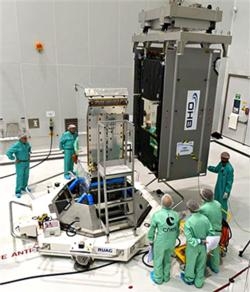Sun, Aug 17, 2014
Two Navigation Satellites To Be Delivered To Orbit August 21
The first of two Galileo navigation satellites to be orbited on Arianespace’s August 21 Soyuz flight has been integrated on its payload dispenser system, marking a key step as preparations advance for this medium-lift mission from French Guiana.

Named “Doresa,” the spacecraft was installed this month during activity inside the Spaceport’s S5A integration hall. It is to be joined on the dispenser system by the mission’s other passenger – “Milena,” whose own installation is forthcoming – in a side-by-side arrangement. The pair then will be mated atop Soyuz’ Fregat upper stage and encapsulated in the protective payload fairing.
“Doresa” and “Milena” – both built by OHB System – are the first FOC (Full Operational Capability) satellites for the Galileo constellation, which will create a European-operated space-based navigation system providing highly accurate, guaranteed global positioning services.
The FOC phase is being funded and executed by the European Union, with the European Space Agency designated as the Galileo system’s development and sourcing agent. The spacecraft payloads, which will generate precision positioning measurements and services to users worldwide, were supplied by Surrey Satellite Technology Ltd. in Guildford, UK.
Designated VS09 in Arianespace’s numbering system, the August 21 flight will be performed from the purpose-built ZLS launch facility for Soyuz – located in the Spaceport’s northern sector near the city of Sinnamary.
Next week’s mission continues Arianespace’s support in the overall Galileo system development. The company’s Starsem affiliate lofted two GIOVE (Galileo In-Orbit Validation Element) satellites in December 2005 and April 2008 on Soyuz missions conducted from Baikonur Cosmodrome in Kazakhstan.
These were followed by four Galileo satellites used for the system’s In-Orbit Validation (IOV) phase, launched in pairs on Soyuz flights performed by Arianespace from French Guiana in October 2011 and October 2012.
(Image provided by Arianespace)
More News
“...no entity, whether a division of government or a private company or corporation, may use information broadcast or collected by automatic dependent surveillance-broadcast >[...]
Growth And Fleet Replacements On The Way International Airlines Group, a joint holding company between British and Spanish air carriers, announced it has ordered up to 76 new Boein>[...]
Expert Analysts Scrutinized the FAA’s Oversight of ATC Organization In a move that appears somewhat mistimed (at best…tone-deaf at worst), the Federal Aviation Adminis>[...]
Community Continues to Push Back Against ADS-B-Facilitated Landing Fees On May 8, a bill to limit frivolous use of ADS-B tracking data was signed into law by Montana Governor Greg >[...]
Duffy Shares Plans to Scale Back Flights at Newark Liberty International After a ‘telecommunications issue’ with Philadelphia TRACON brought yet another string of delay>[...]
 Aero-News: Quote of the Day (05.13.25)
Aero-News: Quote of the Day (05.13.25) IAG Orders 76 Boeing, Airbus Airliners
IAG Orders 76 Boeing, Airbus Airliners FAA Shuts Down ATC Oversight Review Amid Scrutiny
FAA Shuts Down ATC Oversight Review Amid Scrutiny Montanas ADS-B Privacy Bill Signed Into Law
Montanas ADS-B Privacy Bill Signed Into Law Newark Falls Victim to More Equipment Outages
Newark Falls Victim to More Equipment Outages



